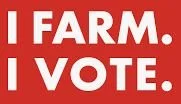Farmers Vote
I’m writing this one the day of yet another historic election. The outcome is yet unknown and may not be for weeks to come. We’ve been here before. Fortunately, America was founded by farmers and up until Jimmy Carter, our last farming president, has been headed by farmers off and on over the centuries.
The US has also had generals, lawyers, businessmen, and legislators. Some of those worked as National Park Rangers while others scooped ice cream at Baskin Robbins as a teenager. They learned the ethics of work and of serving the public, no matter how unglamourous it may have been.
Farming isn’t glamourous, unless you’re one of those celebrity types who only do work when there’s a camera pointed at them. It’s a hard, dirty, and often thankless job that at times barely pays the bills. Believe me, I’ve been doing it one way or another for over 40 years now.
Some of our most esteemed presidents have been farmers, including the Founding Fathers, Washington, Jefferson, and Adams. There was also Monroe, Madison, Jackson, Harrison, Tyler, Grant, Truman and Eisenhower. Although Lincoln wasn’t a farmer by profession, he grew up and worked on a farm, which led him to create the USDA under his administration. And Roosevelt understood the importance of conservation, establishing many of the programs that now fall under the purview of the Farm Bill.
On this Election Day, let’s talk about the Farm Bill, a critical piece of legislation that comes up for renewal every five years. It spans a wide swath of funding for farmers, conservation, and food supplement programs. It’s a big one, too, allocating over $100 billion dollars each year.
Unfortunately, partisan gridlock with our elected officials has held up the passage of the latest farm bill, mostly out of spite. Legislators worked together to pass Farm Bills up to 2018 before they threw their constituents under the bus. They agreed to extend the current Farm Bill to September 2024, but that date passed. As extensions begin to expire, the programs funded will revert to the Agricultural Act of 1949 and the Agricultural Adjustment Act of 1939.
And I want to scream, Are you kidding me!
We’ve come a long way in 85 years in agriculture to go back now. When legislators wrote those Acts, they could have never imagined the issues farmers face today like genetically modified organisms or Right-to-Repair on equipment costing hundreds of thousands of dollars. In 1939, Ford introduced their 9N that was the first to have a hydraulic three-point hitch, now standard on all tractors today. International Harvester debuted the Farmall M, a row crop tractor with six gears, including reverse. Now, many of our tractors have precision GPS for planting, air conditioning, and a good sound system that integrates with our phones via Bluetooth.
Let’s take a look at the major areas of the Farm Bill and how they affect all of us.
Disaster Assistance—You can’t miss it anymore. Natural disasters are headline news every single day it seems. Can you say Hurricane Helene? You can bet all those big peach, peanut, and pecan farmers are lined up at their local USDA offices applying for assistance for all their destroyed crops. Wild fires in the west are decimating wine grape harvest. Ongoing drought is drying up major commodities like corn, soybeans, and wheat. In addition to assistance , a large portion of the Farm Bill administrates the Crop Insurance program.
Conservation—Unfortunately, when cuts are made to the Farm Bill this is the first place the ax falls and in my opinion, it should be the last. Good farmers understand how critical environmental conservation is to a healthy and robust ecosystem that supports agriculture. Let me give you a perfect example of why this is important. There’s a farmer down the road who has a limestone sink in the middle of his crop fields. Until he received technical assistance provided by NRCS through the USDA, he sprayed chemicals and liquid manure right up to the edge of his sink, which is basically a hole in the ground that swallows up water runoff when it rains and collects underground to supply springs and wells for drinking water. Our local municipalities are having to spend millions of taxpayer dollars to clean the chemicals and manure out of the public water supply. With funding, the Conservation District is able to step in and help the farmer with both education and funding.
Other programs help reduce soil erosion, enhance wildlife, and rehabilitate areas damaged by poor agricultural practices.
Rural Communities—Although I travel less than 90 minutes to market, I live in a rural community. Less people in a large area means less tax base and less funding for things like emergency services, healthcare, and infrastructure. Just this year I finally got access to high-speed wireless internet thanks to rural infrastructure grants that were used to place two cellular towers on top of a local mountain top.
Food Security—Perhaps the most controversial part of the Farm Bill are the programs that ensure everyone has access to food. Once known as food stamps, these programs go far beyond handing out money for groceries. Throughout my years as a farmers market organizer and vendor, I’ve set up and participated in numerous programs to help low-income and underserved communities and I’ve worked with legislators to ensure that farmers themselves weren’t left out of the equation.
Your vote is your business, but it is my sincerest hope that, in this election, you’ve considered exactly how the people you vote for ultimately affect your farmers and your food. And maybe…just maybe they’ll be able to work together to get a Farm Bill passed.

